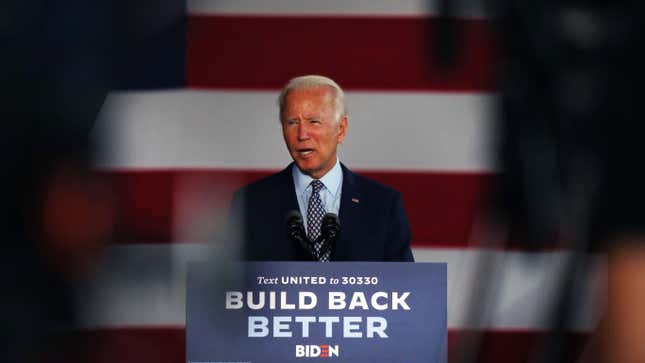
On Tuesday, Democratic presidential challenger Joe Biden released a major update to his climate plan. It has a big splashy number—$2 trillion over four years—and some solid policies. It shows, definitively, that progressives are winning by both putting forward popular policies to address the climate crisis and cranking up the pressure on the Biden campaign to move left. But the thing missing in the plan also reveals what the biggest fight of the next decade will be and the power even a weakened fossil fuel industry holds over the politics of what’s possible.
The plan is structured around infrastructure, clean energy, and environmental justice. Committing to spending $2 trillion over the four years of a presidential term is a serious investment. The U.S. economy is in shambles in the wake of the coronavirus pandemic, and an infusion of $2 trillion for infrastructure spending is one way to kickstart it, especially infrastructure designed to both reduce carbon emissions and withstand the impacts of climate change.
The plan borrows heavily from Sen. Elizabeth Warren and Gov. Jay Inslee, two former presidential candidates who put out climate plans that went beyond the scope of Biden’s original one (clearly Joe Biden reads Earther). Inslee has already said some nice things about the Biden update as have the folks at Evergreen Action who wrote the Inslee plan itself. Feel the love, people.
Biden’s shift has been largely driven by activists who have pushed him to adopt a more aggressive climate plan in line with science. The new plan shows where Biden has been willing to change his approach, but there’s one glaring omissions that shows the biggest climate fight for activists is yet to come. Biden’s plan focuses on the rise of clean energy but doesn’t mention the other side of the coin: how to wind down the fossil fuel industry that is the root cause of the crisis.
This isn’t the first time Biden has sidestepped the industry. Just last week, the joint climate task force he and Sanders created similarly didn’t answer the question of what to do about the fossil fuel industry, which cannot keep producing oil, gas, and coal if we want a stable climate. Though weakened by the pandemic and facing a string of recent courtroom defeats, the fossil fuel industry still has billions in cash and decades of influence at its disposal. Plus, it’s also deeply entwined with American life, including in states Biden is hoping to win such as Pennsylvania where fracking is a huge deal.
While cleaning up the grid and mandating electric cars in the U.S. are certainly good steps to reduce demand for fossil fuels, they don’t tackle the supply side, let alone address the country’s fossil fuel exports. And fossil fuel companies have been exploring other ways to keep the supply flowing, including leaning into plastic production and pushing unproven carbon capture as a solution so they can keep digging. It’s clear Biden is going to need a plan to deal with the industry head on as well as help workers who are caught up in the transition, but he’s not there yet.
So far, the only real fossil fuel plan Biden’s released is a statement at a March debate that he would ban fracking—which his campaign quickly noted only applied to public lands. That’s not going to cut it, unfortunately. The U.S. became a net fossil fuel exporter under President Donald Trump, though the shift started during the Obama administration. On an average day in 2019, the U.S. produced more than 19 million barrels of oil and gas, an all-time high. That’s driven a global surge in methane as well as carbon dioxide. While the coronavirus has dampened things just a teeny, tiny bit, the reality is production needs to rapidly drop.
Global oil and gas use need to fall 37% and 25% respectively this decade to avoid heating the planet more than 1.5 degrees Celsius (2.7 degrees Fahrenheit), a threshold outlined by the international community as crucial to protecting the planet. Given the U.S. role as the top supplier of oil and gas globally, Biden and Congress need to come up with a plan to drive down production.
Climate activists and scholars have put forward a number of plans for doing so, including nationalizing the industry and then phasing out production while protecting workers. Keeping fossil fuels in the ground is a popular policy, according to Data for Progress polling. The same group also found that there’s support for the seemingly radical idea of nationalization, including majorities of support from Democrats and people under 45.
It’s a huge hole given that the other policies in Biden’s new plan such as committing to decarbonize the U.S. electricity sector by 2035, funding projects that are aimed at environmental justice, and creating a Civilian Climate Corps to put people to work are also popular. (The latter is also the most popular policy associated with the Green New Deal).
Yet though the idea of lowering fossil fuel production is also well liked, there are still clearly hurdles to clear for it to reach the White House and Congress. That means activists need to keep pressing Biden to come up with a plan and turning public opinion to their side even further. Ultimately, activists are on the right side of science and history in calling for an end to fossil fuel production. Biden just needs to listen.